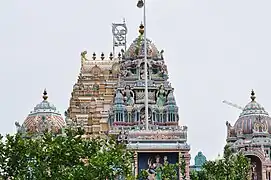Karumariamman
Karumariamman (Tamil: கருமாரியம்மன், romanized: Karumāriamman), also known as Karumari, is the Hindu goddess of smallpox, health and cure. She is also an aspect of the Hindu goddess Parvati and another form of the goddess Mariamman and Renuka. She is primarily worshipped in the villages of South India such as Thiruverkadu which is believed to be her abode.[2]
| Karumariamman | |
|---|---|
Mother Goddess Goddess of Smallpox, Health and Cure | |
 Image of Karumariamman | |
| Other names | Karumari, Adi Parashakti, Renuka, Mariyamman, Renukambal, Bramarambha, Mariamma, Ambigai, Jaganmatha, Sarveshwari, Thiruverkadu Amman, Eswari |
| Affiliation | Parvati, Mariamman, Angala Paramesvari |
| Abode | Thiruverkadu[1] |
| Weapon | Trishula, Khadga, Kapala and Damaru |
| Symbols | Neem, Trishula, knife |
| Day | Sunday |
| Mount | Lion |
| Gender | Female |
| Temples | |
| Festivals | Navaratri, Ādi Thiruviḻa, Panguni |
| Personal information | |
| Siblings | Krishna (Brother) Subhadra (Sister) |
| Consort | Shiva |
| Equivalents | |
| Other equivalent | Shitala Renuka Mariamman |
| Kannada equivalent | Marikambe |
| Part of a series on |
| Shaktism |
|---|
 |
|
|
Karumariamman is usually worshipped by Hindus from South India and Hindu's from Singapore, Malaysia, Sri Lanka, Africa and Australia.
Some Hindus celebrate the festival of Panguni, Ādi Thiruviḻa and Navaratri in her honor, and it is believed that by celebrating this festivals in her honor reduces the risk of health issues and finds cure for health conditions and get relief from smallpox. In the Agama worship, She is worshipped as a combined manifestation of Parashakti, Adishakti, Icchashakti, Jnanashakti and Kriyashakti.
Karumariamman is mainly worshipped among the Thevar and Agamudayar caste in South India who consider her as their family and primary deity as well as their caste deity.
Iconography
Karumariamman is usually pictured as a beautiful young woman with an oval shaped face, wearing a red dress with long jewellery and a big flower garland. And is portrayed having four hands with flames of fire being represented behind the goddess head which indicates lord Surya (Sun god) respects the goddess.
Karumariamman is generally portrayed in a sitting position, often holding a knife in her left hand and a bowl of kumkuma in the right. The other two hands hold a trident (trishula) on the right and a damaru on the left.
Goddess Angala Paramesvari's head is seen and depicted at the foot of goddess Karumariamman. Which symbolises the ego with which thoughts and beliefs will restrict to our own human body.
Legend
According to legend, Karumariamman once disguised herself as a soothsayer and visited the sun-god Surya to predict his future. Surya ignored Karumariamman, refusing to grant her an audience. Angered, the goddess departed. The moment Karumariamman left his abode, Surya started losing his lustre. Soon he was turned into a large coal, causing the earth to plunge into darkness and chaos to reign in the universe. Surya realised his mistake and asked for forgiveness. To pacify Karumariamman, Surya promised that twice a year, he would touch her feet. Karumariamman blessed Surya and he regained his lost lustre. Today, the sun rays fall directly on the feet of Karumariamman at her abode of Thiruverkadu. This event happens in the Tamil calendar months of Panguni (March – April) and Puratasi (September – October).[3]
Temples
India
- The Karumariamman Temple, Tiruverkadu is the main temple for the goddess Karumariamman. Every Sunday is celebrated as the day of Karumari. Adherents can observe the site of sun rays falling on the head the image of the goddess twice a year. The shrine of goddess Karumariamman is made out of wood.
- Sri Devi Karumariamman Temple, Whitefield, Bengaluru.
- The Karumariamman temple, Ragavendra
Malaysia
- Karumariamman Temple, Penang located in Penang, Malaysia. The temple is noted for having the largest rajagopuram, or main sculpture tower, in Malaysia. It stands at a height of 72 feet (22 m). The entrance of the rajagopuram, at 21 ft (6.4 m) tall and 11 ft (3.4 m) wide, is also the biggest in Malaysia.
- Karumariamman Temple, Jalan Sentul, Kuala Lumpur, Malaysia.
Singapore
- Sri Mariamman Temple, Singapore, located in Singapore. The temple is dedicated to Mariamman and also Karumariamman.
Africa
- Sri Devi Karumariamman Thirukoil, located in Johannesburg, South Africa.
Gallery
 Goddess Karumariamman at Sri Mariamman Temple, Singapore
Goddess Karumariamman at Sri Mariamman Temple, Singapore Side view of the Rajagopuram of the Karumariamman Temple, Tiruverkadu, taken on 6 February 2022
Side view of the Rajagopuram of the Karumariamman Temple, Tiruverkadu, taken on 6 February 2022
Notes
- Arulmigu Devi Karumri Amman Temple, Thiruverkadu
- Hindu Religious and Charitable Endowments Act, 1959
- "Story Of Devi Karumariamman And Surya". www.hindu-blog.com. 25 September 2020. Retrieved 12 April 2023.
References
- W.T. Elmore, Dravidian Gods in Modern Hinduism.
External links
![]() Media related to Karumariamman at Wikimedia Commons
Media related to Karumariamman at Wikimedia Commons
